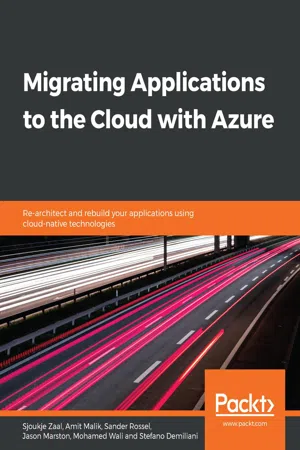
Migrating Applications to the Cloud with Azure
Re-architect and rebuild your applications using cloud-native technologies
- 494 pages
- English
- ePUB (mobile friendly)
- Available on iOS & Android
Migrating Applications to the Cloud with Azure
Re-architect and rebuild your applications using cloud-native technologies
About this book
Modernize your apps with Microsoft Azure by moving web, desktop, and mobile apps to the cloud
Key Features
- Decide which migration strategy is most suitable for your organization and create a migration roadmap
- Move existing infrastructure to Azure and learn strategies to reduce cost, increase storage, and improve ROI
- Design secure, scalable, and cost-effective solutions with the help of practical examples
Book Description
Whether you are trying to re-architect a legacy app or build a cloud-ready app from scratch, using the Azure ecosystem with.NET and Java technologies helps you to strategize and plan your app modernization process effectively.
With this book, you'll learn how to modernize your applications by using Azure for containerization, DevOps, microservices, and serverless solutions to reduce development time and costs, while also making your applications robust, secure, and scalable.
You will delve into improving application efficiency by using container services such as Azure Container Service, Azure Kubernetes Service (AKS), and more. Next, you will learn to modernize your application by implementing DevOps throughout your application development life cycle. You will then focus on increasing the scalability and performance of your overall application with microservices, before learning how to add extra functionality to your application with Azure serverless solutions. Finally, you'll get up to speed with monitoring and troubleshooting techniques.
By the end of this book, you will have learned how to use the Azure ecosystem to refactor, re-architect, and rebuild your web, mobile, and desktop applications.
What you will learn
- Use DevOps and containerization technologies to modernize your applications and infrastructure
- Build microservices using Azure Service Fabric
- Develop scalable applications using Azure Functions
- Manage and deploy your application code and database connectivity
- Secure and monitor your applications in Azure effectively
- Design for high availability and disaster recovery
Who this book is for
This book is for.NET and Java developers who want to modernize their applications using Azure. Solution architects and experienced developers interested in modernizing legacy applications using Azure will also find this book useful. Some prior understanding of cloud computing concepts will be beneficial.
Frequently asked questions
- Essential is ideal for learners and professionals who enjoy exploring a wide range of subjects. Access the Essential Library with 800,000+ trusted titles and best-sellers across business, personal growth, and the humanities. Includes unlimited reading time and Standard Read Aloud voice.
- Complete: Perfect for advanced learners and researchers needing full, unrestricted access. Unlock 1.4M+ books across hundreds of subjects, including academic and specialized titles. The Complete Plan also includes advanced features like Premium Read Aloud and Research Assistant.
Please note we cannot support devices running on iOS 13 and Android 7 or earlier. Learn more about using the app.
Information
Connecting to the Database
- Working with Azure SQL
- Connecting to SQL Server Management Studio
- Connecting to Azure SQL from .NET Core
- Connecting to Azure SQL from Java
- Understanding Cosmos DB
- Working with the MongoDB API
- Working with the Redis cache database
Technical requirements
- SQL Server Management Studio (SSMS): https://docs.microsoft.com/en-us/sql/ssms/download-sql-server-management-studio-ssms
- Visual Studio 2017: https://www.visualstudio.com/downloads/
- Eclipse 2019: https://www.eclipse.org/downloads/download.php?file=/technology/epp/downloads/release/2019-09/R/eclipse-java-2019-09-R-linux-gtk-x86_64.tar.gz
Working with Azure SQL
Picking your version
Creating an Azure SQL Database
- Either find your SQL databases or go to Create a resource and find SQL Database.
- In the blade that opens, select a subscription.
- Select or create a resource group.
- Give the database a name. This is your database, so it doesn't have to be unique across Azure.
- The next part is a little tricky; we need to create an actual server:
- Provide a name for your server; it has to be unique across all of Azure.
- Enter the name of your server's admin.
- Enter a password that meets the requirements (Azure will show you what those requirements are if you don't meet them).
- Confirm the password.
- Select a location.
- Keep Allow Azure services to access server checked. For non-development purposes, it's recommended to uncheck this option as it gives any Azure resource access to your server, even those not in your current subscription.
- Now, we can go back to the SQL database settings. We don't want an elastic pool right now.
- The pricing tier is interesting; you can go for the Basic tier here, which is already more than we need. I've picked standard with some extra DTUs:

- Leave the collation.
- When you have filled everything out, you can click Create and the SQL database will be created; this may take a few minutes:

Pricing tiers
Table of contents
- Title Page
- Copyright and Credits
- About Packt
- Contributors
- Preface
- Planning Application Modernization
- Strategies for Application Modernization Using Azure
- Building Your Application Migration Roadmap
- Implementing Containerization and DevOps in a Development Cycle
- Getting Started with Docker and Kubernetes
- Deploying Highly Scalable Apps with Kubernetes
- Modernizing Apps and Infrastructure with DevOps
- Building a Web and Microservices Architecture on Azure
- Designing Web Applications
- Scalability and Performance
- Building Microservices with Service Fabric
- Going Serverless and Deploying to the Cloud
- Building Scalable Systems with Azure Functions
- Connecting to the Database
- Managing and Deploying Your Code
- Securing Your Azure Services
- Planning for Security, Availability, and Monitoring
- Diagnostics and Monitoring
- Designing for High Availability and Disaster Recovery
- Assessments
- Other Books You May Enjoy